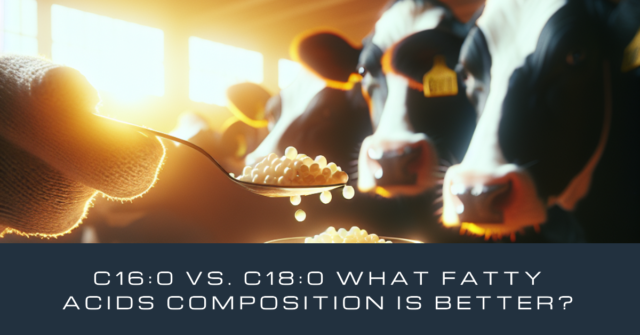
This article by Ecolex Animal Nutrition, a leading global specialist in rumen bypass fat technology, explores the comparative benefits of C16:0 and C18:0, providing valuable insights for dairy farmers. Enhancing milk production and quality remains a top priority in dairy farming. One critical factor that has attracted significant attention is the role of fatty acids in dairy cow diets, particularly C16:0 (palmitic acid) and C18:0 (stearic acid). The choice between these two fatty acids can significantly impact energy intake, milk yield, and overall cow health.
The Purpose of Rumen Bypass Fats
When incorporating rumen bypass fats into dairy cow diets, it is essential to understand the primary objective. If the goal is to boost overall energy intake and mitigate the risk of rumen acidosis, any fat that effectively bypasses the rumen will achieve this aim. This approach ensures cows receive the necessary energy to maintain health and productivity without the adverse effects associated with rumen fermentation.
However, if the objective is to specifically enhance milk fat yield, palmitic acid (C16:0) is the clear winner. Extensive research has demonstrated that C16:0 significantly outperforms C18:0 in increasing milk fat production.
The Superiority of Palmitic Acid (C16:0)
Supplementing dairy cow diets with C16:0 has been shown to significantly elevate milk fat yield compared to C18:0. This is mainly because the mammary gland more efficiently absorbs C16:0, making it more readily available for milk production. Studies indicate that cows fed C16:0-enriched diets produce higher volumes of milk and milk fat, showcasing improved feed-to-milk conversion rates.
A diet enriched with C16:0 (typically 75-85% palmitic acid) positively impacts milk fat yield, 3.5% fat-corrected milk, and overall feed efficiency. Farmers can incorporate C16:0 up to 1.5% of the diet’s dry matter to achieve these benefits. The linear increase in energy partitioning towards milk production with higher C16:0 intake further highlights its effectiveness.
Practical Implications for Dairy Farmers in the Indian Subcontinent
For dairy farmers in this area of the world, selecting the right fatty acids for cow diets can be transformative. With the growing demand for high-quality milk, leveraging the advantages of C16:0 supplementation can significantly enhance milk fat content and overall yield. Here are some practical steps for incorporating C16:0 into dairy diets:
- Dietary Adjustment: Gradually introduce C16:0-enriched supplements to the cow’s diet. Allow time for adaptation and monitor the cows for any changes in health or milk production.
- Balanced Nutrition: Ensure the overall diet remains balanced, providing adequate nutrients to support increased milk production without compromising cow health.
- Monitoring and Evaluation: Regularly monitor milk yield and fat content to assess the effectiveness of C16:0 supplementation. Adjust the diet as necessary based on performance metrics and cow health.
- Consultation with Experts: Collaborate with a nutritionist or veterinary expert to tailor the supplementation strategy to the specific needs of the herd, considering factors such as lactation stage and overall health.
Conclusion
In conclusion, while both C16:0 and C18:0 can enhance the energy intake of dairy cows, C16:0 (palmitic acid) stands out for its superior ability to boost milk fat yield. By effectively directing more energy towards milk production and improving feed-to-milk conversion, C16:0 supplementation offers substantial benefits for dairy farmers focused on maximizing milk quality and quantity. As the dairy industry continues to progress, adopting scientifically-backed nutritional strategies like C16:0 supplementation can help farmers remain competitive and meet the increasing demand for high-quality milk.

Data source: Loften JR, Linn JG, Drackley JK, Jenkins TC, Soderholm CG, Kertz AF. Invited review: palmitic and stearic acid metabolism in lactating dairy cows. J Dairy Sci. 2014;97(8):4661-74. doi: 10.3168/jds.2014-7919.

















